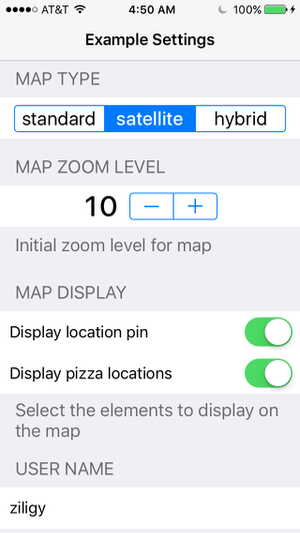An easy-to-use settings manager to define, access, and store NSUserDefaults the Swift way.
- via Carthage: github "ziligy/JGSettingsManager"
- or copy JGSettingsManager folder to your project
- Declare storage items using JGUserDefault for each
- Select a SettingsCell UI component for each item
- Create Sections array to load into the Manager
import JGSettingsManager
struct UserDefaults {
let mapType = JGUserDefault (key: "mapTypeIndex", defaultValue: "standard") // String
let zoomLevel = JGUserDefault (key: "zoomLevel", defaultValue: 10) // Int
}
class SettingsTable: JGSettingsTableController, SettingsSectionsData {
override func viewDidLoad() {
super.viewDidLoad()
self.tableSections = loadSectionsConfiguration()
}
internal func loadSectionsConfiguration() -> [Section] {
let userDefaults = UserDefaults()
let sections = [
Section (
header: "Map Type",
footer: "",
settingsCells: [
SegmentedControlTableCell(stringValue: userDefaults.mapType, segments: ["standard","satellite","hybrid"]),
],
heightForFooter: 10.0
),
Section (
header: "Map Zoom Level",
footer: "Initial zoom level for map",
settingsCells: [
StepperTableCell(stepperData: userDefaults.zoomLevel, minimumValue: 1, maximumValue: 30)
]
)]
return sections
}
}
-
Add TableController to Storyboard
-
Assign SettingsTable as Custom Controller
-
select Table style: Grouped for nice formatting
-
That's it!
-
The JGSettingsManager will save the user's values in NSUserDefaults for persistent storage even when the app is closed.
- Use the JGUserDefault items
print(zoomLevel.value())
prints the last value from the settings table or the default
- Switch
- Bool
- Text
- String
- Stepper
- Int
- Double
- Segmented
- Index as Int
- String
or define your own
See attached Example project
- Xcode 7.2
- Swift 2
- iOS 9.0+
- Snap!Location micro-app incorporating JGSettingsManager

